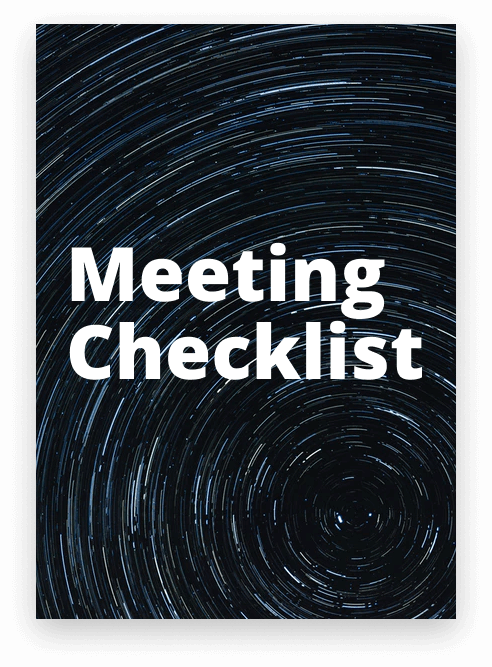There is a widespread opinion claiming that gathering people for discussing work duties and identifying main strategic objectives is nothing more than a relic of the past. You may support this claim because they do steal a lot of time and energy. Or you might disagree with this point of view because all these events happen for a reason. The purpose of meetings always includes precise objectives. As a member of any team, you most likely attend or even host meetings. It’s important for attendees to know why meetings are called, and that often starts with a description in the agenda sent out. The last thing someone wants to do is be in a pointless meeting. In this blog, we outline some key aspects of communicating the purpose and goals of a business meeting and the high-level reasons for calling meetings.
How to Communicate The Purpose of Meetings
There are multiple formats of meetings in the workplace that you are likely familiar with. Each serves different general purposes. In the context of your organization or team, it is important to detail the purpose of a meeting. The last thing your team wants to do is go to a meeting that doesn’t need to be called in the first place. Communicating the purpose early in the process is key, and this means including it in the agenda.

Communicating Purpose in the Agenda
Consider including the purpose of the meeting in the agenda. An agenda serves to inform attendees, including a succinct description of the meeting’s purpose. The meeting agenda typically includes questions and topics to discuss, and what is expected from each individual member.
Accomplishing Meeting Goals
Use the agenda as your guide to accomplishing your meeting goals during the meeting. With a succinct agenda, meeting members should be well prepared for what is needed during the meeting. In the meeting minutes, reiterate the purpose included in the agenda, as well as key topics and questions to address during the meeting. Have a notetaker document the meeting will help track your progress toward achieving the goals of calling the meeting.
Reasons to Have Meetings
No matter what type of meeting you are planning, you still need to keep in focus its main objective. A meeting objective is what measures the productivity of the session. You have done a good job if you manage to meet the objective. Otherwise, you just wasted your and everyone else’s time. It becomes more difficult to keep everything in order when you need to attend (or host) multiple meetings during a day due to numerous agendas. These meeting objective examples will simplify your task and might work in different situations, depending on the purpose of the meeting.
The vast majority of meeting routines falls into the following categories (according to the main objective of the meeting):
- Make important decisions
- Provide and sharing updates
- Brainstorm new ideas
- Boost team morale

Reason 1: Make Important Decisions
Usually, meetings with such objectives imply making major decisions. Those decisions are crucial for the project and will have far-reaching consequences, so everything must be discussed with top managers, directors, and stakeholders. Let’s take a meeting about the future merger agreement with a smaller company as an example. This process will likely redefine the whole order of things, so you need to analyze all the pros and cons before proceeding.
Reason 2: Provide Status Updates
Meetings on status updates are also important for the well-being of any company. While the main purpose of the meeting is to inform people about progress and plans, they are also an opportunity to review the challenges and difficulties on the way to the final goal. Ask attendees to share their thoughts on their work in progress as well as already completed tasks. Sharing insights may help everybody realize the importance of meetings.
Reason 3: Generate Fresh Ideas
Don’t be afraid to call meetings to generate fresh ideas. Just don’t organize them too often, there is still work to be done. Brainstorm meetings are most effective in the beginning or mid-phase of the new project, for example, when you are about to launch a marketing campaign. Make the ideation session as informal as possible so that everyone will feel at ease and relaxed. This way, you will have higher chances to come up with extraordinary ideas.
Reason 4: Boost Team Morale
Meetings for boosting the team’s spirit are not only common in workplaces but it is also very effective. But some managers prefer to call them when things aren’t going well. Instead, make them regular but super short. Everyone will feel involved in the process, appreciated for their achievements, and motivated to work effectively. No one will ever question the purpose of a business meeting from then on.

You might find it difficult to track all these things in your mind, so why not try to make things a little bit easier with our meeting planning checklist?
Key Takeaways
Whatever the meeting is about, when everyone understands the purpose of meetings scheduled, you’ll accomplish your goals without needless distractions. It is important to add a short description in an agenda outlining the purpose and goals of the meeting. With a clearer description of the purpose and goals, you’ll find meetings will be more efficient and productive.
The use of meeting management software can help streamline the meeting management process. yoyomeeting makes it easy to communicate your purpose in the agenda, as well as documenting meeting notes and sending out meeting minutes. Get a free trial of yoyomeeting, a web-based meeting software for Microsoft Outlook designed to simplify your meetings with a set of straightforward tools.
Improve your meetings with yoyomeeting for Outlook
Streamline your meeting process with yoyomeeting. We offer a lot more on meeting management with hacks on how to improve your meeting culture and create value for the purpose of business meetings.







